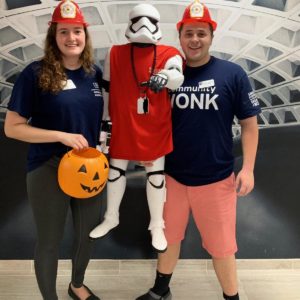On a day one of most AU students’ college careers, they will be welcomed and guided by RAs during the move-in process. Moving in about 1000 students a day on AU’s small campus is a feat that requires leadership from the frontline. When lines were longer than anticipated in certain directions, I used my knowledge of working directly in the flow to determine what was the barrier. This story begins on the Northside of Campus. Car lines were about 400-deep (about 3 hours wait). I arrived and observed the University’s top officials hurriedly walking around the area and discussing the issue. They kept saying that the we need to shorten the line but offered no solutions.
I noticed the elevators were the primary cause of back-ups. A normal-operating elevator will stop at every floor that “calls” for it. However, during move-in the elevators reach capacity typically after 1 to 2 stops. Instead of going to the destination to release the occupants, elevators continue to stop on every floor that calls it. This creates a significant inefficiency in transporting the belongings and people to their rooms.
 I came up with a solution to this problem from watching The Suite Life of Zack and Cody. Zack and Cody lived in a fancy penthouse in New York City. At their home, an elevator attendant controlled where the elevator went, no matter if someone was calling it. This mode is called “independent mode.” I saw a keyhole that allowed for AU’s elevators to be switched from normal to independent mode and realized this would make the process much faster. I contacted my supervisor who pushed off my idea. He was very stressed and ignored my idea. I then took the risk and directly called Facilities Management to change the elevator mode. I explained my role and my idea. They agreed that it could make the process go much faster. Within a few minutes, the elevator technician made the switch with his key. About 20 minutes later, the 400+ car line was reduced to only 10. The process was almost working too well as staff began eagerly looking for work. The contracted lead for the moving company acknowledged that my proactive response and idea is what fixed the issue. The higher ups shrugged his comments off.
I came up with a solution to this problem from watching The Suite Life of Zack and Cody. Zack and Cody lived in a fancy penthouse in New York City. At their home, an elevator attendant controlled where the elevator went, no matter if someone was calling it. This mode is called “independent mode.” I saw a keyhole that allowed for AU’s elevators to be switched from normal to independent mode and realized this would make the process much faster. I contacted my supervisor who pushed off my idea. He was very stressed and ignored my idea. I then took the risk and directly called Facilities Management to change the elevator mode. I explained my role and my idea. They agreed that it could make the process go much faster. Within a few minutes, the elevator technician made the switch with his key. About 20 minutes later, the 400+ car line was reduced to only 10. The process was almost working too well as staff began eagerly looking for work. The contracted lead for the moving company acknowledged that my proactive response and idea is what fixed the issue. The higher ups shrugged his comments off.
After it became operating at a steady pace, I moved over to the Southside of Campus where I found the same issue. This time, I noticed and addressed it before the people in positional leadership spots got there. When they arrived, they saw that I took over the operation. The director said, “you always seem to be finding the trouble today.” I laughed and thought to myself about the difference in perspectives we had. Again, within an hour the line was at a controllable pace.
At the end of the first day of move-in, I spoke to my supervisor and requested that my schedule change from being assigned to a particular spot to be a floater. She acknowledged that the director had already requested the adjustment. While the director did not show gratitude in the moment that we saw each other earlier, I felt more gratitude from her when she requested I take on a position with much more responsibility and leadership. I felt confident in taking the risk of adjusting the elevators because of the trusting environment of the organization. I had worked for the organization for two years prior and developed relationships with its members. I knew that this was a minor risk worth taking. My decision resulted in a much better first impression for thousands of students, something that is immensely important in higher education and business in general.
Now that I have spoken about move-in, let me dive into my other what I primarily did as an RA. I worked as an RA for two years (2018-2020) and supervised the residence hall front desks for one year (2017-2018). As an RA, I had three primary responsibilities:
-
-
- Promote an inclusive and welcoming environment by hosting community events
- Providing direct support and referrals to residents
- Serving as a first responder outside the University’s normal operating hours
-
To be honest, I struggled with the events portion of the role. This was surprising to me as I simultaneously held the role of Lead Event Producer for the University’s Speakers Bureau. However, the events we were encouraged and sometimes mandated to host felt forced and ingenuine. It was difficult to develop and host rated-PG events for a college audience.
 Rather that dwelling on my struggle with hosting events, I thought about what the purpose of hosting events. I realized that the purpose was to check in with residents and encourage inter-personal relationships. With this, I worked to build unique relationships with my residents. I brought in my peers who were officers in clubs to speak about their experiences. I strayed away from hosting corny events and moved towards hosting events that were relevant in American culture and student life in the particular week.
Rather that dwelling on my struggle with hosting events, I thought about what the purpose of hosting events. I realized that the purpose was to check in with residents and encourage inter-personal relationships. With this, I worked to build unique relationships with my residents. I brought in my peers who were officers in clubs to speak about their experiences. I strayed away from hosting corny events and moved towards hosting events that were relevant in American culture and student life in the particular week.
In my time as an RA, I basically trademarked “let’s go a walk.” When residents were struggling or causing disruptive behavior, I naturally told them that they had to go on a walk with me around campus or an area they felt comfortable doing so. The walks helped residents decompress because the environment was far less intimidating than an office or dorm room. Typically, we would walk to a coffee shop about a ½ mile away from campus and back. The 15-minutes was a perfect amount of time for residents to get everything off their chest and for me to advise.
When most people think of an RA, they envision someone showing up to their door at 1am to tell them to quiet down. While I did respond to noise complaints, I was more frequently called to emergencies. Although I don’t have the exact numbers, I probably responded to 5 medical emergencies, 5 drug violations, 5 residents in crisis, and 15 alcohol-related illnesses. No one really knows what hey are going to do in an emergency until they are directly in one. As someone who wants to go into emergency public service, I was fortunate to get a glimpse of what its like to be a first-responder as a RA.

